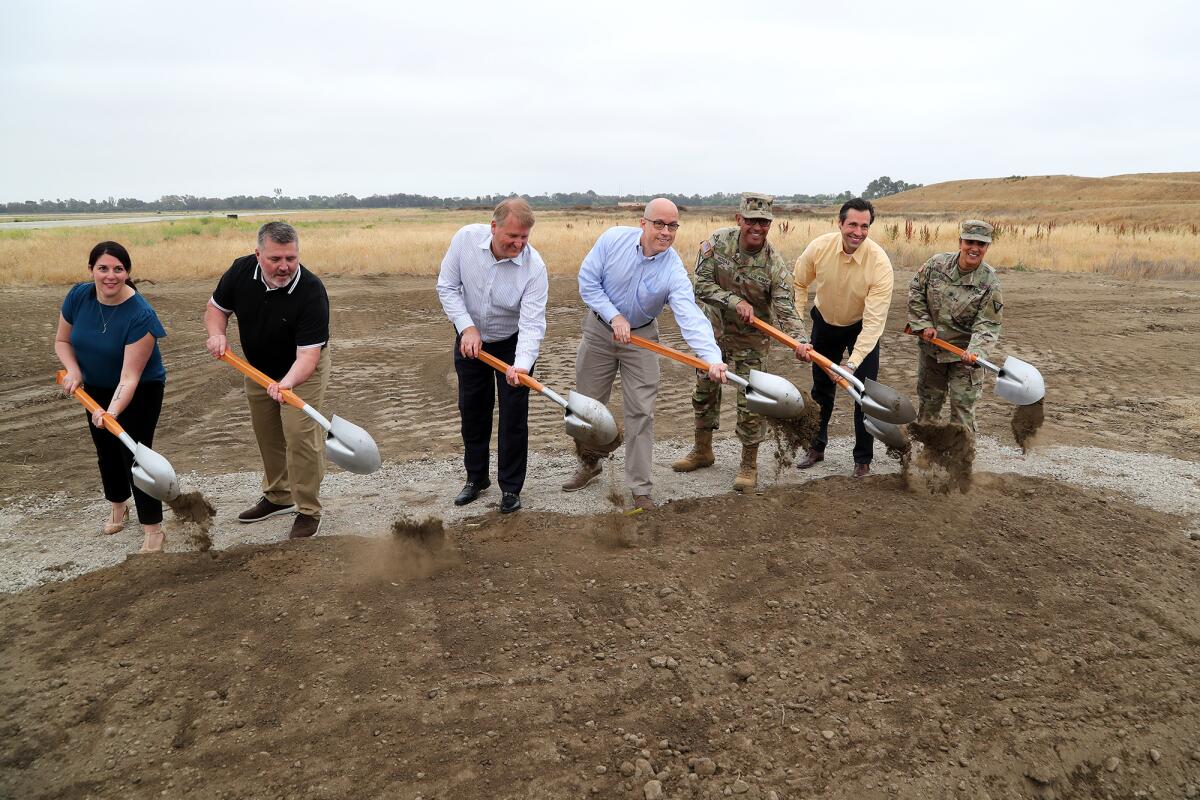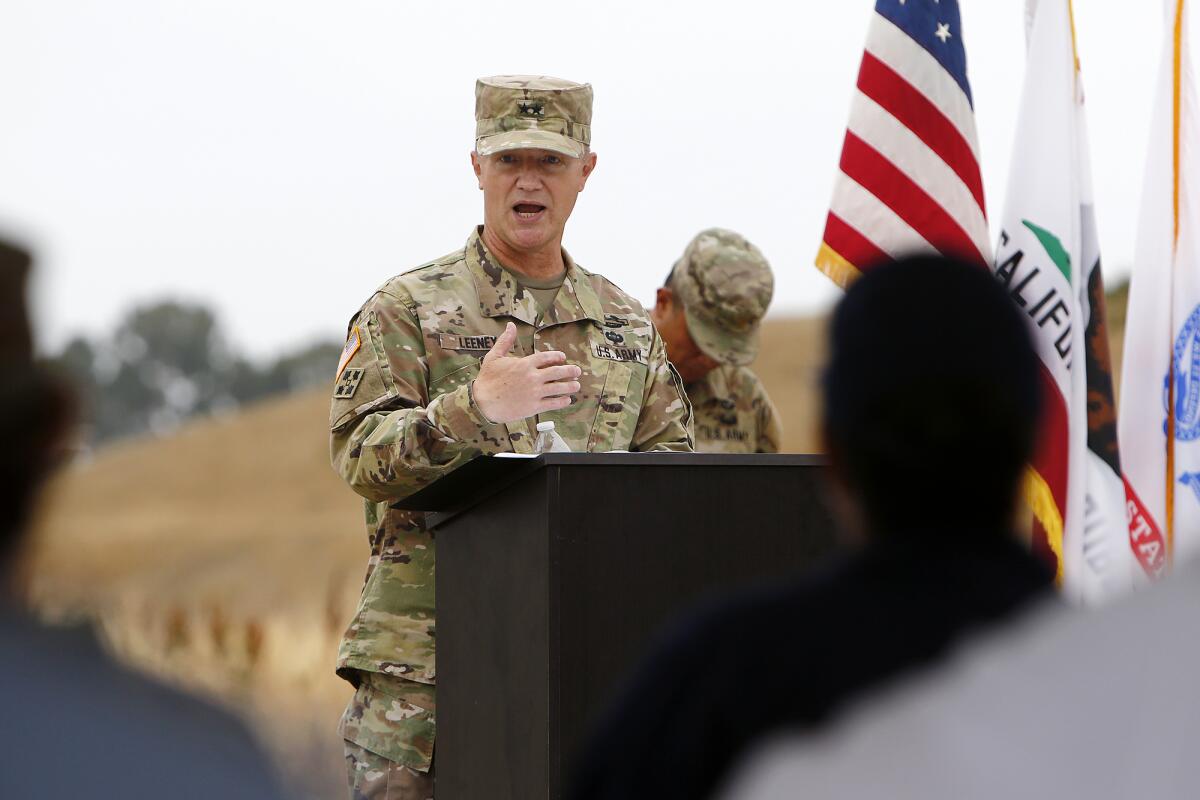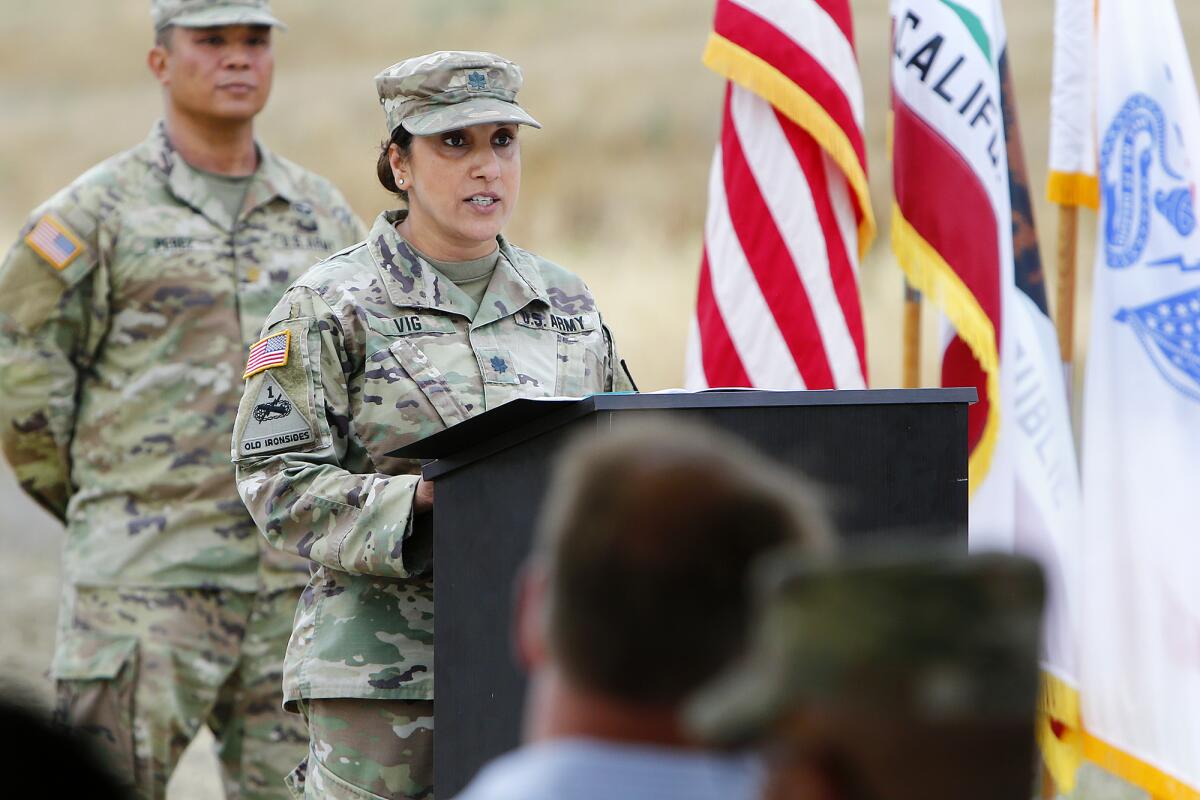National Guard breaks ground on Los Alamitos solar microgrid, doubling down on environmental sustainability

The California National Guard captures the public’s attention by deploying gas-guzzling helicopters and Humvees. But the Golden State’s military leaders have come to understand that environmental sustainability is also a critical part of their mission.
Joint Forces Training Base Los Alamitos has a years-long track record of national recognition for its novel environmental initiatives. The National Guard Bureau in Arlington, Va., has awarded four awards to the Orange County base, which could be on track to a fifth for its efforts to bake environmentalism into its operations.
On May 19, National Guard and U.S. Army Corps of Engineers leaders held a groundbreaking ceremony for a 99-acre solar energy microgrid and storage project at Los Alamitos that would provide more than enough power to keep the base running for weeks after a major earthquake or other major disaster.

“We’re in a world where we have to operate no matter what is happening outside of our fence line, and this base is the perfect example of it [as] the hub for emergency operations in Southern California,” said Paul Farnan, principal deputy assistant secretary of the U.S. Army for Installations, Energy and Environment.
The California Governor’s Office of Emergency Services has a regional crisis room on the base where state and federal officials would oversee recovery after a cyberattack, civil unrest, tsunami or another major disaster. Humanitarian aid from around the country would initially be flown in on military aircraft to Los Alamitos Army Air Field, which is the only military airport between Pt. Mugu and Camp Pendleton. A fleet of helitankers leased by the Orange County Fire Authority to help extinguish wildfires is expected to return to the airfield in June.
In the event of a power outage today, the National Guard would use diesel generators to power critical buildings including the air traffic control tower.
Bright Canyon Energy will pay for the installation and maintenance of solar panels manufactured in Phoenix. In return, the company will get a percentage of the revenue from selling renewable energy generated during normal conditions to San Diego Gas & Electric. The microgrid is expected to come online next summer as the Los Angeles Department of Water and Power completes dismantling the natural gas-powered Haynes Generating Station in Long Beach.

Secretary of Defense Lloyd Austin III has recognized climate change as a national security threat that will impact the military’s missions for decades. Rising oceans put piers and coastal bases at risk of flooding. Service members will also have to train to fight in drier conditions.
“This is the Army doing its part to address climate change. The clean energy day-to-day will feed into the Southern California grid and during emergencies will power our installations. It’s more carbon-free electricity powering out society,” Farnan said.
Maj. Gen. Michael Leeney, commander of 10,000 soldiers with the 40th Infantry Division, said he first learned of the Los Alamitos solar microgrid project at a meeting in 2014.
“I find it very gratifying that eight years later I’m about to put a shovel in dirt on this project. Energy resilience is something we’ve been pursuing as a state, just like the Army,” Leeney said.
The push to get the military plugged into renewable energy sources lands as federal officials grapple with a toxic legacy from the decades-long practice of firefighting foam containing per- and polyfluoroalkyl substances during aviation mishaps and training drills. These forever chemicals have been linked to cancer diagnoses endured by many veterans. Plumes of these pollutants have been found floating beneath 700 active and closed bases across the nation. In 2019, Army groundwater testing identified Joint Forces Training Base as the service’s second-worst polluted base — it was a Naval Air Station until 1973.
An investigation of the nature and extent of contamination at Los Alamitos is still pending, according to Department of Defense records.
Base environmental officer Tom Tandoc leads a two-person office that has spearheaded the recent sustainability movement at Joint Forces Training Base.
Los Alamitos Army Airfield was nationally recognized in 2018 for being one of two Army airports in the country to have a program that prevents birds from colliding with military aircraft. Fowl sucked into an engine or slamming into the fuselage can wreak expensive damage. As a steward of public land, the Guard also has a legal obligation under federal law to mitigate the impacts of base operations on wildlife, especially migratory birds.

Sparrows, red-tailed hawks, Cooper’s hawks, barn owls, Canadian geese, European starlings, cliff swallows and mourning doves are among the species that either live on the base or migrate through it. Contractors can disperse some birds with noisemakers or trap and relocate some raptors more than 100 miles away from airports, Tandoc said.
Military leaders have recognized Los Alamitos’ success in avoiding bird strikes, prompting Congress to permanently fund the program.
In April, the base was recognized for partnering with Vista Paint to recycle more than a ton of expired paint. Dozens of paint cans were warehoused after crews restriped many of the base’s traffic lanes. Reflective material mixed into the paint contributed to its short shelf life.
Due to the state’s hazardous waste disposal rules, the National Guard looked at expensive plans to ship the paint cans to landfills in Arizona, Nevada or across the U.S.-Mexico border.
“Headquarters was prepared to budget for that extreme cost, but the fact we were able to find a partner to recycle was a very good thing for everyone,” Tandoc said.
The nationwide recognition of the paint-recycling project at Los Alamitos is a win for the state and the military as a whole, he said.
“It’s not that hard to do the right thing if you think about it a little bit,” he said.
Daniel Langhorne is a contributor to Times Community News.
All the latest on Orange County from Orange County.
Get our free TimesOC newsletter.
You may occasionally receive promotional content from the Daily Pilot.



